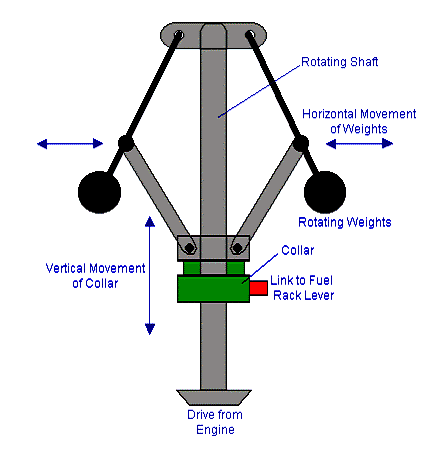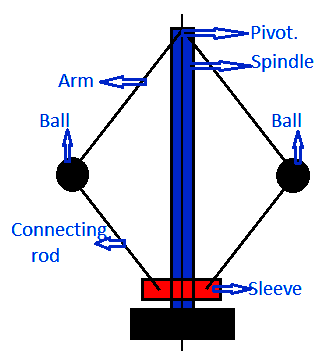Governor Definition Engine
A governor is also the mechanical device that controls the average speed of an engine when there is a variation in load.
It maintains the engine speed within specified limits regardless of load variations. It is basically a speed-controller device that is used to measure and control machine speed despite load variations.
The governor changes the configuration when the load on the engine changes and controls the fuel supply accordingly. It acts as a cruise control mechanism that drives the engine at the set speed limit of your selection, even if the load varies.
It detects changes in load and adjusts the throttle accordingly. Unlike a flywheel, it can control speed but is unable to store and supply energy when needed. It is used in most engine-driven applications such as tractors, lawnmowers, automobiles, etc.
Definition Isochronous
A governor is termed isochronous when the equilibrium speed is constant for all radii of rotation of balls within working range. For the slightest change of speed due to a change in load, such a governor would jump from one extreme position to another. Thus, an isochronous governor is oversensitive.
Equation of Speed
From the equation above, it can be observed that for every configuration, there are maximum and minimum limits of speed between which the speed varies without change of the configuration.
From the figure, for a given height h, the speed can vary between N 1 and N 2 without a change of the configuration.
The maximum speed at which the governor will rotate is NA when the sleeve is in the highest position and has a tendency to ascend, and the minimum speed is NB when the sleeve is at the lowest position and has a tendency to descend.
Porter Governor Working
When the engine load is reduced, the engine speed will increase suddenly, and the spindle speed will also increase. As the spindle speed increases, the two fly balls also move faster around the spindle. The centrifugal force will push balls outward, moving the ball upward.
As the ball moves upward, the arms also move upward, and the sleeve attached to the lower part of the also moves upward. The upward movement of the sleeve activates the throttle valve through a mechanism attached to the sleeve to reduce the fuel supply to the engine.
A decrease in fuel supply reduces speed. Therefore speed is maintained. In the second case, the engine speed decreases when the engine load increases. As the engine speed decreases, the spindle speed also decreases, and the centrifugal force in the balls decreases.
Therefore balls come down with arms. As the arms move down, the sleeve attached to the arm also comes down, and this activates the throttle valve, which increases the fuel supply. Due to the increase in fuel supply, engine speed also increases.
Porter Governor Construction
Porter governors have two fly balls, which are attached to the arms of the porter governors. Both these arms are taped on top of the axis.
It is powered by a spindle engine. The arms parts are attached to the central sleeve just above the fly balls. This sleeve moves up and down according to the speed of the balls.
The spindles have stoppers in place to limit the vertical movement of the axle. This sleeve is a heavy central load. The sleeve speed controls the opening and closing of the throttle valve.
Frequently asked questions (FAQs) that could be included in your article about governors:
What is a governor in an engine?
A governor in an engine is a mechanical device designed to regulate the speed of the engine by controlling the fuel supply, ensuring it remains stable despite variations in load.
How does a governor work?
Governors typically use centrifugal force from rotating components (such as fly balls) to detect changes in engine speed. When the speed exceeds a set limit, the governor adjusts the throttle to reduce fuel intake, maintaining the desired speed.
What are the types of governors used in engines?
Common types include centrifugal governors, like the Porter governor mentioned, and electronic governors that use sensors and actuators to achieve speed control.
What is an isochronous governor?
An isochronous governor maintains a constant speed regardless of load changes, making it sensitive to even slight variations in engine speed.
Where are governors used?
Governors are essential in various engine-driven applications such as tractors, lawnmowers, automobiles, and industrial machinery to ensure efficient and stable operation.
How do Porter governors function?
Porter governors utilize centrifugal force from fly balls to adjust a sleeve connected to the throttle valve. When engine speed increases due to reduced load, the governor decreases fuel supply, and vice versa, to maintain consistent speed.
What is the construction of a Porter governor?
A Porter governor consists of two fly balls attached to arms, connected to a central sleeve. The sleeve moves vertically based on ball speed, controlling throttle valve opening and fuel supply.
Why are governors important in engines?
Governors prevent engine overspeeding or underspeeding, optimizing performance, fuel efficiency, and ensuring longevity by reducing wear caused by inconsistent speeds.
Can governors be adjusted or calibrated?
Yes, governors can often be adjusted to set desired speed ranges or to accommodate specific operating conditions, ensuring optimal engine performance.
What are the advantages of using governors in engines?
Governors help in maintaining stable engine speed, improving efficiency, reducing fuel consumption, and ensuring safer operation by preventing sudden speed changes.






